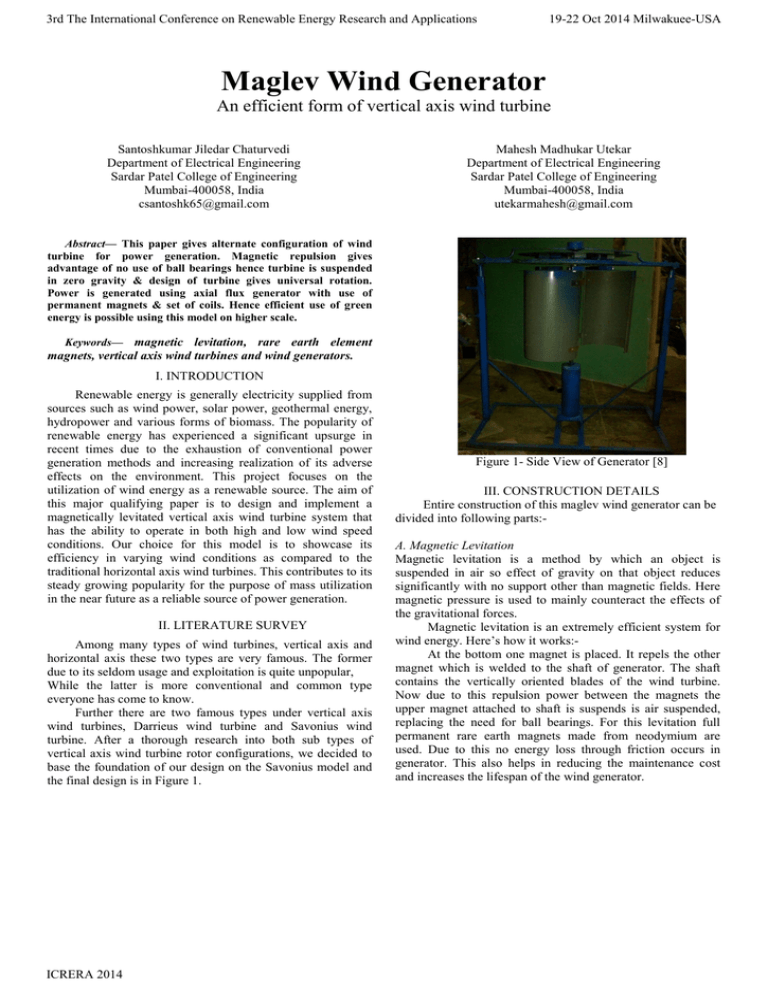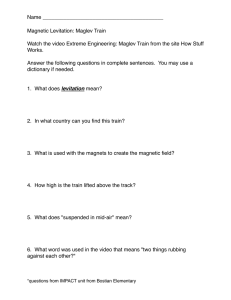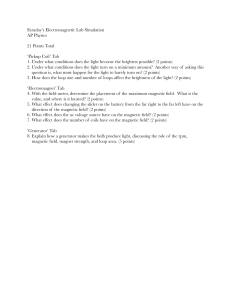Maglev Wind Generator
advertisement

3rd The International Conference on Renewable Energy Research and Applications 19-22 Oct 2014 Milwakuee-USA Maglev Wind Generator An efficient form of vertical axis wind turbine Santoshkumar Jiledar Chaturvedi Department of Electrical Engineering Sardar Patel College of Engineering Mumbai-400058, India csantoshk65@gmail.com Mahesh Madhukar Utekar Department of Electrical Engineering Sardar Patel College of Engineering Mumbai-400058, India utekarmahesh@gmail.com Abstract— This paper gives alternate configuration of wind turbine for power generation. Magnetic repulsion gives advantage of no use of ball bearings hence turbine is suspended in zero gravity & design of turbine gives universal rotation. Power is generated using axial flux generator with use of permanent magnets & set of coils. Hence efficient use of green energy is possible using this model on higher scale. Keywords— magnetic levitation, rare earth element magnets, vertical axis wind turbines and wind generators. I. INTRODUCTION Renewable energy is generally electricity supplied from sources such as wind power, solar power, geothermal energy, hydropower and various forms of biomass. The popularity of renewable energy has experienced a significant upsurge in recent times due to the exhaustion of conventional power generation methods and increasing realization of its adverse effects on the environment. This project focuses on the utilization of wind energy as a renewable source. The aim of this major qualifying paper is to design and implement a magnetically levitated vertical axis wind turbine system that has the ability to operate in both high and low wind speed conditions. Our choice for this model is to showcase its efficiency in varying wind conditions as compared to the traditional horizontal axis wind turbines. This contributes to its steady growing popularity for the purpose of mass utilization in the near future as a reliable source of power generation. II. LITERATURE SURVEY Among many types of wind turbines, vertical axis and horizontal axis these two types are very famous. The former due to its seldom usage and exploitation is quite unpopular, While the latter is more conventional and common type everyone has come to know. Further there are two famous types under vertical axis wind turbines, Darrieus wind turbine and Savonius wind turbine. After a thorough research into both sub types of vertical axis wind turbine rotor configurations, we decided to base the foundation of our design on the Savonius model and the final design is in Figure 1. ICRERA 2014 Figure 1- Side View of Generator [8] III. CONSTRUCTION DETAILS Entire construction of this maglev wind generator can be divided into following parts:A. Magnetic Levitation Magnetic levitation is a method by which an object is suspended in air so effect of gravity on that object reduces significantly with no support other than magnetic fields. Here magnetic pressure is used to mainly counteract the effects of the gravitational forces. Magnetic levitation is an extremely efficient system for wind energy. Here’s how it works:At the bottom one magnet is placed. It repels the other magnet which is welded to the shaft of generator. The shaft contains the vertically oriented blades of the wind turbine. Now due to this repulsion power between the magnets the upper magnet attached to shaft is suspends is air suspended, replacing the need for ball bearings. For this levitation full permanent rare earth magnets made from neodymium are used. Due to this no energy loss through friction occurs in generator. This also helps in reducing the maintenance cost and increases the lifespan of the wind generator. 3rd The International Conference on Renewable Energy Research and Applications 19-22 Oct 2014 Milwakuee-USA value, no matter from which direction wind is flowing. Due to this the wind tale circuitry required in conventional wind mills is eliminated here. Figure 2 -Concept of Magnetic Levitation [7] Some factors need to be assessed in choosing the permanent magnet selection that would be best to implement the maglev portion of the design. Understanding the characteristics of magnet materials and the different assortment of sizes, shapes and materials is critical. There are four classes of commercialized magnets used today which are based on their material composition each having their own magnetic properties [5]. The four different classes are Alnico, Ceramic, Samarium Cobalt and Neodymium Iron Boron also known Nd- Fe-B. Nd-Fe-B is the most recent addition to this commercial list of materials and at room temperature exhibits the highest properties of all of the magnetic materials. It can be seen in the B-H graph shown in Figure-3 that Nd-Fe-B has a very attractive magnetic characteristic which offers high flux density operation and the ability to resist demagnetization. So the Nd-Fe-B is preferred here for levitation. Figure3–B-H Curve of Various Magnetic Materials [6] B. Wind Turbine Design It is observed that in our streamlined design it concentrates the mass momentum of the wind to the bottom of the sails and allows for smoother torque during rotation. A standard Savonius model for this design would have created a lot of instability around the shaft and on the base which could eventually lead to top heaviness and causing the turbine to tip over. The main factor for our design is due to its attachment to the stator of our generator as shown in Figure 4. In addition to this Savonius design provides universal rotation. By universal rotation we mean that the blades will start rotating once the speed of air is more than the cut off ICRERA 2014 Figure 4 -Rotors Connected to Stator [8] C. Generator Design When designing a generator it is important to have a firm grasp of the basic laws that govern its performance. In order to induce a voltage in a wire a nearby changing magnetic field must exist. The voltage induced not only depends on the magnitude of the field density but also on the coil area. The relationship between the area and field density is known as flux (Φ) [1]. The way in which this flux varies in time depends on the generator design. The axial flux generator uses the changing magnetic flux to produce a voltage. The voltage produced by each coil can be calculated using Faraday's law of induction: V = N dø/dt [3]. In the design of stator we have put 10 set of coils in 10 slots. Each coil consists 300 turns of copper wire. The copper wire used here is of 28 SWG (standard wire gauge).Each one of our coils has a measured resistance of 40Ω; a smaller gage wire would further reduce this resistance. Figure 5 –Copper coils of 300 turns each [8] For rotor designing two circular plates containing 10 permanent magnets on each are used here. The angular distance between to magnets is 36 degree equal to the distance between two coils. The magnets placed on these two plates create the magnetic fields. These magnets are of ferrite type with the powers of 2500 gauss each. 3rd The International Conference on Renewable Energy Research and Applications Rotor containing magnets Stator containing coils Figure 6 –Stator & Rotor [8] In our design we have chosen to sandwich the coils between two attracting magnets [4]. The magnets are so arranged that if one pair’s magnetic field is in upward direction then adjacent pair’s magnetic field will be in downward direction. Field Figure 7 – Coils and Magnets arrangement at rotor [8] The magnitude of the flux is greater when the coil in a magnetic field is perpendicular to the field [2]. So is the reason for the above design. When due to wind turbine starts rotating the magnetic field created by the magnets also rotates which get cut by the stationary coils and here comes the Faraday’s law of electromagnetic induction due to which emf is induces in coils. IV. FEATURES A. Project output: Voltage: 8.48volts (pk-pk) Frequency: 23.63Hz Rotation Speed of turbine: 320 rpm Current: 16.8 mA VI. ACKNOWLEDGMENT The authors wish to thank our faculty and colleagues in SPCE and VJTI for their support in writing this paper, especially: Vidya Joshi for assistance with the diagrams, Popat Kandhare for a useful discussion over the content, and Santosh kavare for proof-reading. 1. 2. 3. 5. 6. 7. B. Constructional Features of Maglev Wind Generator The vertically oriented blades of the wind turbine are suspended in the air replacing any need for ball bearings. ICRERA 2014 For the levitation full permanent rare earth magnets are used which are very reliable and durable. No requirement of wind tale circuitry due to universal rotation given by Savonius design. Due to use of magnetic levitation at the base of turbine effect of gravity on turbine operation is much lesser. It provides less start up energy and reaches to high speed in less time. Frictional losses are almost negligible due to levitation which reduces the starting torque requirement. No use of Dynamo so elimination of carbon brushes. High rotating speed: the rotating speed is increases under the same wind speed compare to conventional one. High power output: the power output actual is raise adherently under the same wind speed. V. CONCLUSION The important concept of magnetic levitation explained in this paper gives the frictional losses which can assume to be negligible. So this helps in achieving greater efficiency. If we use more numbers of coils in stator and more numbers of magnets in rotor the emf generated in coils will be more. To get more output another way is to reduce turbine’s own inertia by using lighter weight materials for turbine. So that for the same wind speed it will rotate faster, hence it will generate more power. 4. Figure 8 – Practical Model Output [8] 19-22 Oct 2014 Milwakuee-USA 8. VII. REFRENCES Giancoli, Douglas C. Physics for scientists & engineers with modern physics. Upper Saddle River, N.J: Prentice Hall, 2000. Gonen Turan, Electric Power Distribution System Engineering, Boca Raton: CRC P,2008. Hambley, Allan R. Electrical Engineering Principles and Applications (4th Edition).Upper Saddle River: Prentice Hall, 2007. Mohan, Ned. Electric Drives An Integrative Approach, Mnpere, 2003. “Magnet Design”. 2000 Magnet Sales & Manufacturing Company, Inc. http://www.magnatokyo.com/eng/service/tokusei.html http://ffden2.phys.uaf.edu/212_fall2009.web/Wendy_ Presler/Homepage.html Diploma Final Year Project Report on “Maglev Wind Generator” by Mahesh Utekar in VJTI (2011-12)


